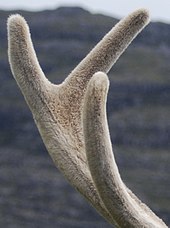Swept

The Gefege 's Jägersprache by sweeping abraded antler skin, the so-called Bast , from after the antler growth formed antlers of deer (z. B. Roe , red deer , elk ) to trees and shrubs as well as the location where it was swept.
Created by sweeping
To rub off the dying bast skin, the animals choose a woody plant corresponding to their strength, from weak vegetation to a rod as large as an arm, so that the strength of the animal can be estimated based on the thickness of the rod and the height up to which the deer has swept can be. The bark detached by the sweeping sticks to the trunks in small shreds, while bark exposure caused by eating damage ( peeling ) can be distinguished by the recognizable tooth marks (winter peeling ) or large, distant strips (summer peeling ).
Basically, the rule “old sweeps before young” applies, which means that older deer sweep in June / July of the year, with younger deer the start of sweeping can be postponed until September.
Roebucks prefer weak, low trunks for sweeping and often scratch the ground (“suddenly”, “squat”), which is rarely the case with deer. Plants with strong arms, especially of the deciduous tree species, are also attacked by roebucks at sweeping heights.
All game species that sweep prefer to use the types of wood that are seldom found in the area, they particularly prefer larch or Douglas fir trunks , the resin of which they seem particularly comfortable. But also heister of hardwoods ( maples , cherries , oaks ) are often swept.
See also
literature
- Ilse Haseder , Gerhard Stinglwagner : Knaur's large hunting dictionary. , Augsburg 2000, ISBN 3-8289-1579-5
- Franz Müller and Daniel G. Müller (Hrsg.): Wildlife information for the hunter: Volume 1 hair game . Verlag Kessel, Remagen 2004, ISBN 3-935638-51-5 .
